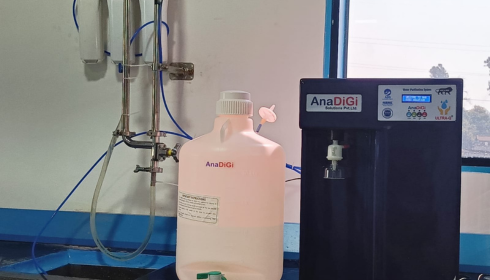We all know water is essential. We drink it, we cook with it, we use it in cleaning and production processes. But what most folks don’t realize is how precise water needs to be when you’re dealing with sensitive instruments, lab testing, or commercial kitchens. In some cases, one wrong droplet can ruin an entire process or batch. And that’s not just annoying—it’s expensive.
Whether you’re managing a research lab, running a restaurant, or maintaining high-end medical or industrial gear, water isn’t just water. It has to be clean. Pure. Controlled. And the systems that ensure that? Well, they’re the unsung heroes of modern infrastructure.
Let’s take a deeper dive into why these specialized water systems matter—and how they’re quietly supporting industries we all depend on every day.
The Hidden Risk: Contaminants You Can’t See
It’s easy to think water that’s clear and odorless is “clean,” but purity goes way beyond appearances. Dissolved solids, bacteria, minerals, and even chemical residues from pipes or municipal treatment can pose big problems for specialized equipment or processes.
If you’re running any sort of delicate hardware—think lasers, autoclaves, HVAC chillers, or lab analyzers—those unseen particles can cause corrosion, scaling, or malfunctions over time. That’s why sensitive equipment water protection has become a huge part of operational planning in hospitals, manufacturing plants, and data centers alike.
These systems aren’t just about filtering water—they’re about ensuring consistent chemistry, temperature, and particulate control. Because when tolerances are tight, “almost pure” just won’t cut it.
Labs Live or Die on Water Quality
Step into any diagnostics lab, pharmaceutical facility, or biotech company, and you’ll quickly find that water plays a central role in nearly every process. From preparing reagents and rinsing glassware to feeding ultra-sensitive analyzers, the margin for error is razor-thin.
A proper laboratory water system isn’t just about filtration. It typically includes multiple stages—reverse osmosis, deionization, UV sterilization, and carbon polishing—to remove all possible sources of interference. Some setups even control for temperature and flow rates, ensuring every sample and wash meets exacting standards.
Without it? You risk cross-contamination, inconsistent results, and failed experiments. And in the world of research, that’s not just frustrating—it’s a loss of time, money, and sometimes credibility.
Food Service Depends on Consistency
Now let’s shift to a completely different environment: the kitchen.
Whether it’s a Michelin-starred restaurant or your favorite local café, water touches everything—beverages, ice machines, steamers, dishwashers, even dough mixers. And when the water isn’t right, neither is the food.
Minerals can cause limescale buildup in coffee machines. Chlorine can mess with fermentation or change how baked goods rise. And poor-tasting tap water? It affects everything from soups to sodas.
That’s why so many restaurants invest in food service water systems that filter and condition their water before it touches anything. These systems are often tailored to the equipment in use—ice machines get one type of filter, espresso makers another. The result? Longer equipment life, better food, and happier customers.
Tailored Systems for Real-World Problems
The beauty of today’s water systems is how customizable they are. Gone are the days when your only option was a big clunky filter with vague promises. Now, systems are designed around specific use cases.
Need ultrapure water for semiconductor manufacturing? There’s a setup for that. Trying to keep your humidifiers from getting gunked up with minerals? There’s a treatment plan for that, too.
It all starts with testing—understanding what’s in your incoming water, and what your application needs. From there, engineers can build a system with just the right mix of filtration, purification, and pressure control.
And the bonus? Many of these systems are now compact, energy-efficient, and smart-tech enabled. You can track water quality from your phone and get alerts when it’s time for maintenance or cartridge changes.
Maintenance: Easy, but Critical
No water system, no matter how high-tech, is set-it-and-forget-it. Regular upkeep is key to performance—especially in environments where stakes are high.
Thankfully, modern systems are easier than ever to maintain. Many are modular, with quick-change cartridges and color-coded indicators. Some even have automatic back-flush cycles to keep things running smoothly between services.
But here’s the kicker: skipping even a single maintenance window can have a cascading effect. That’s especially true in lab or kitchen environments, where contamination can spread quickly or create costly downtime.
So, while the tech has evolved, the responsibility hasn’t. If water quality matters to your business, so should its ongoing care.
Regulations and Compliance Aren’t Optional
It’s not just about preference—it’s about compliance. From FDA guidelines for food and beverage operations to ISO certifications for laboratories, many industries are required to meet strict water quality standards.
Failing to comply can mean more than just bad results or customer complaints. It can lead to fines, failed inspections, and even shutdowns.
That’s why certified water systems—and the documentation that comes with them—are such a critical investment. They help you stay audit-ready, inspection-proof, and legally protected, no matter what industry you’re in.
Cost vs. Value: Why It Pays to Invest Upfront
Yes, specialized water systems can be pricey upfront. But they’re often far cheaper than the alternative.
Consider the cost of replacing a broken espresso machine, repeating a failed lab run, or dealing with customer refunds because your soda “tasted weird.” Now add up all the time lost, the staff hours wasted, and the potential brand damage. Suddenly, that filtration system looks like a bargain.
And the good ones? They last for years. With proper maintenance, many deliver consistent performance for a decade or more—quietly protecting your operations while you focus on everything else.
Final Thoughts: It’s Just Water… Until It Isn’t
Water is one of those things we take for granted. Until it stops working. Until it tastes wrong. Until it ruins a test or breaks a machine.
But with the right water system—whether it’s for sensitive equipment water protection, fine-tuned food service water, or a high-precision laboratory water system—you’re not just managing risk. You’re investing in smoother operations, better results, and long-term peace of mind.

